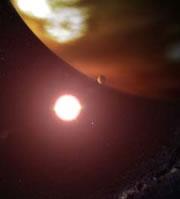 Some extrasolar planets could be formed from compacted carbon, putting them high in the cosmic bling stakes.© NASA
Some extrasolar planets could be formed from compacted carbon, putting them high in the cosmic bling stakes.© NASAPlanets orbiting other suns could be made partly of pure diamond, US researchers have claimed.
They think that some 'extrasolar' planets - of which more than 100 have now been discovered - may have condensed from gas and dust that is rich in carbon. This could produce worlds made largely of hard carbon compounds such as silicon carbide, otherwise known as the industrial abrasive carborundum.
These planets might have thick crusts of almost pure carbon. Their uppermost crust would consist of graphite, calculate Marc Kuchner of Princeton University in New Jersey and Sara Seager of the Carnegie Institution of Washington. But deeper down, high pressure would transform graphite into the other more glamorous form of carbon: diamond.
What's more, carbon on the surfaces of these planets could form hydrocarbons, giving them soft, tarry coatings, or even lakes and seas of liquid hydrocarbons such as methane.
The recent images of the surface of Saturn's moon Titan, taken by the European Space Agency's Huygens spacecraft, suggest that this world may have such 'petroleum' rivers and lakes, although the moon's solid fabric is thought to be ice, rock and iron.
By Jupiter
Kuchner and Seager were inspired to consider the possibility of carbon planets by a suggestion made by cosmochemist Katharina Lodders of Washington University in St Louis, Missouri. Last year, she argued that Jupiter's methane-rich atmosphere is evidence that this giant planet condensed around an initial nucleus of carbon-based material.
It is generally thought that the planets in our Solar System have cores of metal (iron and nickel) and rock (silicates, like the rocks on Earth). These would be the first materials to condense out as the gas and dust cloud, or nebula, that surrounded the Sun when it first formed, began to cool down.
But Lodders proposed that carbon-rich material could have accumulated in a ring called the 'tar line' around the Sun, where carbon gases diffused outwards and then condensed. Carbon-rich dust grains from the outer nebula would also spiral inwards and add to this tar line. There was plenty of carbonaceous material in the early solar nebula, and some of it still roams the Solar System as rocky lumps called carbonaceous chondrites, which occasionally fall to Earth as meteorites.
Kuchner and Seager decided to explore Lodder's idea to see whether, in other planetary systems, entire planets might form around the tar line. They calculate that, in contrast to gas-giant planets with carbon-rich cores surrounded by huge amounts of gas, some carbon planets might be more like Earth: solid, smaller than Jupiter, and perhaps with a thin layer of atmospheric gases such as methane or carbon monoxide1. 'Rain' from these atmospheres would create oceans of tar on the planetary surface.
The centres of these planets would probably consist of silicon carbide or titanium carbide. But the researchers argue that a thick layer of graphite could form on top of this. And at depths of a few kilometres, this would be transformed into diamond.
As carbon is the key element in terrestrial life, Kuchner and Seager claim it is possible that life - perhaps even intelligent life - might exist on an Earth-sized carbon planet. Whatever such beings might be like, in their oil-rich world "they would not go to war over such a common trifle as carbonaceous fuels", say the researchers.
